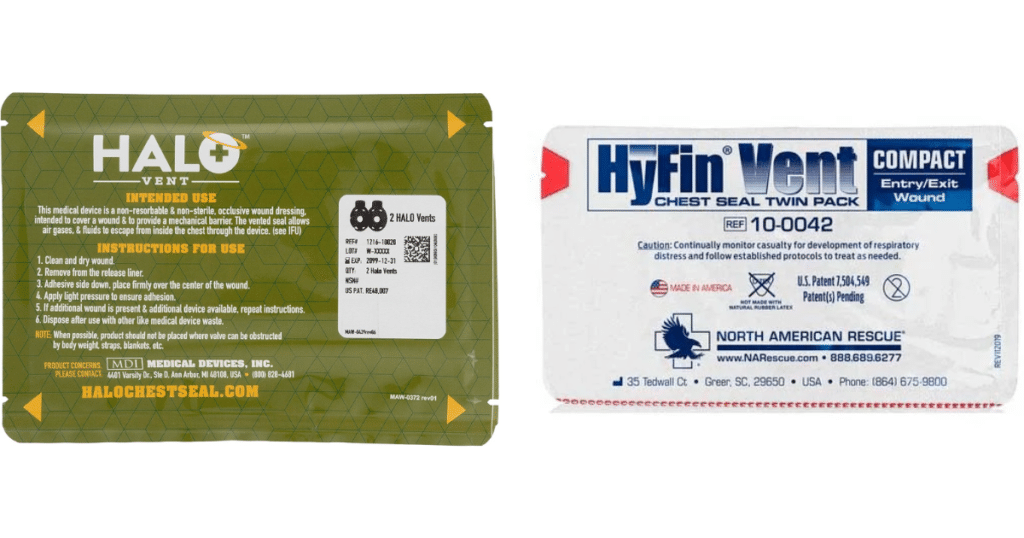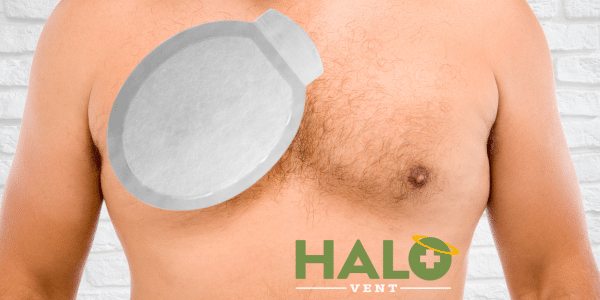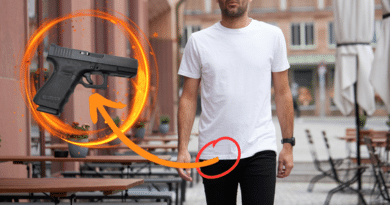The Halo Chest Seal: An EDC Life-Saving Tool for Chest Trauma
Chest trauma, especially a penetrating chest wound, can be extremely dangerous and life-threatening if not treated quickly and properly. A collapsed lung, known as a pneumothorax, is a common consequence of chest trauma that prevents proper breathing and oxygenation of the blood. Thankfully, modern medical devices like the Halo Chest Seal provide an effective way to treat pneumothorax and other chest injuries in the field.
In this article, we are going to dive deeper into the world of chest seals and look specifically at the Halo Chest Seal and why it is something you should have in your kit for emergencies.
For those who are unsure what a Halo Chest Seal is, click here to view the details.
Disclaimer: This article is for informational purposes only. Simply owning a chest seal does not make you a trained professional. It is highly recommended that you take some sort of medical training course, such as the one from Iron Forge Consulting Group, to ensure you know how to properly use these life-saving devices.
Table of contents
- What is a Halo Chest Seal?
- How Does a Halo Chest Seal Work?
- How to Use a Halo Chest Seal
- What is the Difference Between a Chest Seal and an Occlusive Dressing?
- Why Every IFAK Needs Chest Seals
- When to Use the Halo Chest Seal
- What is a Chest Seal for Pneumothorax?
- Approved Chest Seal Alternatives
- Storing and Replacing Chest Seals
- When Not to Use the Halo Chest Seal
- Proper Training and Protocols
- What Do I Carry in My IFAKs and EDC Med Kit?
What is a Halo Chest Seal?
The Halo Chest Seal is a medical device designed specifically for treating penetrating chest wounds. It works by creating an airtight seal over the wound, preventing air from entering the chest cavity through the wound. This allows the lung to re-expand after collapsing from the trauma.
Halo Chest Seals are made up of two components — the adhesive sealing disc, and the one-way valve. The disc is a large oval-shaped adhesive pad, around 4 inches wide and 5 inches tall. The adhesive is extremely sticky but will not stick to moist surfaces like blood or sweaty skin. This allows it to form a complete seal.
The one-way valve is attached to the center of the sealing disc. This valve allows air to escape from the chest cavity but does not let any air back in. This prevents pressure from building up inside the chest, which would cause difficulty breathing and blood flow.
How Does a Halo Chest Seal Work?
When applied to a penetrating chest wound, the adhesive disk sticks to the chest around the wound, creating an airtight seal. This prevents any more air from entering the chest cavity through the wound when the victim inhales.
The one-way valve then allows the trapped air already in the chest to escape as the victim exhales. However, it closes when they inhale again, not allowing any more air to rush into the chest cavity. This process lets the lung re-expand after collapsing from the initial trauma.
Proper chest sealing with the Halo allows the victim to breathe easier and get oxygenated blood flowing again. It buys valuable time to get the wounded to advanced medical care.
How to Use a Halo Chest Seal
Using the Halo Chest Seal is quick and straightforward. Follow these steps:
- Expose the wound by cutting or removing clothing if necessary. Do not try to remove any impaled objects.
- Wipe the skin clean and dry around the wound so the adhesive will stick.
- Peel the backing off the seal disc.
- Place the seal completely over the wound, pressing firmly on the adhesive to get a good seal.
- Ensure the one-way valve is properly positioned over the wound and oriented upward.
- Continue to monitor the victim’s breathing and be prepared to re-seal if necessary.
- Get medical help and evacuate the victim as soon as possible.
If the victim’s condition worsens, be prepared to perform interventions like CPR or needle decompression if trained to do so. Extra Halo seals should be readily available in first aid kits to re-seal or seal additional wounds as necessary.
What is the Difference Between a Chest Seal and an Occlusive Dressing?
The main difference between a chest seal and an occlusive dressing is:
- A chest seal is specifically designed to treat pneumothorax by sealing penetrating chest wounds and allowing trapped air to escape.
- An occlusive dressing is a generic wound covering that provides a barrier to stop bleeding and protect the injury.
Chest seals have two key features occlusive dressings lack:
- One-way valve: This valve on chest seals allows trapped air to leave the chest cavity but doesn’t let any more air enter. Occlusive dressings have no valve mechanism.
- Larger size: Chest seals are larger, often 4×6 inches or more, allowing them to completely seal wounds on the chest. Occlusive dressings are typically smaller bandages.
While an occlusive dressing can be used to cover small chest wounds temporarily, they are not a substitute for an actual chest seal. The sealing and valve functions of chest seals are vital for effectively treating larger penetrating chest trauma and pneumothorax.

Using a regular occlusive dressing on a serious chest wound increases the risk of tension pneumothorax since air will keep entering the chest cavity without being able to escape. Chest seals are mandatory equipment for emergency responders for this reason.
Why Every IFAK Needs Chest Seals
Having a stock of Halo Chest Seals in your first aid kit can truly save lives in situations involving chest trauma. Here are some key reasons why every kit should contain them:
- Treats one of the most life-threatening battle and trauma injuries — penetrating chest wounds.
- Helps responder seal wounds quickly without special training. Very easy to use.
- Lighter and more compact than older-style chest seals.
- It can be applied while the victim is still wearing body armor or gear.
- Waterproof adhesive keeps working even when wet.
- It can be used on both entry and exit wounds.
- Allows trapped chest air to escape, preventing tension pneumothorax.
- Helps lung re-expand after collapsing from trauma.
- It buys time to get advanced medical aid. Victims can often breathe easier once sealed.
- Inexpensive and disposable. A new seal should be used on each wounded.
- Long shelf life. Usually good for up to 5 years in kits.
- It may be the only option to treat a chest wound at the injury site, far away from a hospital.
- It can be used on wounds to the chest, back, and even neck.
Chest seals used to be bulky and hard to apply without training. The Halo Chest Seal is compact, easy to use, and could save your life or the life of a loved one in an emergency. Keep a supply in your first aid kits, Go-Bags, and anywhere chest trauma is possible.
When to Use the Halo Chest Seal
The Halo Chest Seal should be applied immediately on any penetrating chest wounds where air can enter the chest cavity. Signs that a chest seal needs to be applied urgently include:
- Gunshot or stab wounds to the chest area. Seal any penetrating injury sites.
- Sucking chest wound. The wound makes a sucking sound when the victim inhales.
- Frothy blood coming from the mouth.
- Difficulty breathing, shortness of breath.
- Chest not rising normally with breaths.
- Severe chest pain.
- Signs of shock, such as rapid heartbeat, pale skin, and confusion.
- Obvious trauma, even without noticeable wounds due to internal injuries.

Ideally, proper chest sealing should be done within the first few minutes after any significant chest injury occurs. The sooner air is prevented from entering the chest, the better the victim’s outcome will be.
However, chest seals can still be beneficial even longer after an injury if the victim is showing signs of tension pneumothorax like difficulty breathing, low oxygen, or collapsing lung. Apply whenever you suspect air is leaking into the chest that shouldn’t be.
What is a Chest Seal for Pneumothorax?
A chest seal for pneumothorax is a device used to treat a collapsed lung (pneumothorax) caused by penetrating chest trauma.
When the chest wall is penetrated, air can enter the chest cavity through the wound. As more air enters, pressure builds up and causes the lung to collapse. This is known as a tension pneumothorax, and it prevents proper breathing and oxygenation of the blood.
A chest seal covers and seals the open wound on the chest wall. This prevents any further air from entering and allows the built-up pressure to escape, letting the lung re-expand.
Specifically, chest seals for pneumothorax do two critical things:
- Create an airtight seal over the wound. The adhesive seals off the hole in the chest wall so no more air can enter the chest cavity.
- Have a one-way valve. This valve lets trapped air escape the chest as the victim exhales but doesn’t allow air back in on inhalation. This decreases pressure and allows the collapsed lung to reinflate.

Chest seals designed for pneumothorax are essential life-saving items to have in any first aid or trauma kit. They are a temporary intervention that can sustain breathing and circulation until more advanced medical treatment is available. Common brands like the Halo Chest Seal and Hyfin Chest Seals all serve this specific purpose.
Approved Chest Seal Alternatives
While the Halo Chest Seal is one of the most effective and popular brands, there are a few other approved alternatives:
- Bolin Chest Seal: Very similar in design and function to the Halo Chest Seal.
- Hyfin Chest Seal: Unique built-in vented channels let air out without a separate valve.
- Asherman Chest Seal: Original military-issue chest seal brand. It’s less common today.
Many other generic chest seals are also available. Look for seals made specifically for penetrating chest trauma rather than just generic wound dressings. Official military-approved chest seals are ideal.
Storing and Replacing Chest Seals
Like any first aid supply, be sure to store Halo Chest Seals properly:
- Store at room temperature, away from extreme heat or cold.
- Check and replace expired seals. Shelf life is usually 3-5 years.
- Keep inside sealed packets until ready to use.
- Do not open the pouch until a seal is needed to keep it sterile.
- Discard and replace any opened or damaged seals.
- Restock used seals in your kits immediately after use.

Having an unopened Halo Chest Seal readily available could mean the difference between life and death after severe chest trauma. Inspect your kits regularly and rotate stock to ensure seals are working properly when needed. With some basic training, anyone can employ this simple, life-saving device.
When Not to Use the Halo Chest Seal
While the Halo Chest Seal is designed to treat penetrating trauma, there are some situations when it should not be used:
- Blunt trauma to the chest without an open wound. It could make breathing more difficult.
- Groin, abdomen, or neck injuries. Different seals are designed for these areas.
- EMS or medical personnel arrive and take over care.
- The seal will not stick due to moisture or uneven surfaces.
- Decompression needles or chest tubes are available, and the person is trained to use them.
- The victim has stopped breathing or is in cardiac arrest. Focus efforts instead on CPR.
Remember that the Halo seals treat open chest wounds only. Leave the seals in place once applied until EMS or medical staff can reassess the victim. Never try to peel off and reuse a seal.
Proper Training and Protocols
While the Halo Chest Seal itself is easy to use, it is still important to get proper training for any first aid or trauma response protocols you may need to follow:
- Take accredited first aid and CPR/AED courses. Learn principles of trauma care.
- Drill applying seals rapidly while wearing protective gear.
- Practice coordinating with a team of responders.
- Refresh knowledge and skills every 1-2 years.
- Know your scope of practice and when to get more advanced medical aid.
- Carry quality sealants, airways, gloves, shears, and other gear.
- Have protocols for quickly stopping bleeding after sealing wounds.
A chest seal alone is not enough — true preparedness requires regular training and the right equipment used properly at the right times. But with some instruction, the Halo Chest Seal is an easy-to-use and highly effective way to save lives after catastrophic chest injuries.
What Do I Carry in My IFAKs and EDC Med Kit?
As mentioned throughout this article, there are a few types of chest seals. Which do I personally use in my kits? Two of them, actually.
Related Article: EDC Medical Kit — More Important EDC Item Than a Firearm?
I run the Halo Chest Seals in all of my med kits that I keep off-body, such as in my vehicle, battle belts, chest rig med kits, etc.

On my person, I carry the Hyfin Chest Seal (Compact) due to the small profile of the chest seals and it being easier to fit in my PHLster Pocket Emergency Wallet as well as my Live the Creed Pocket Trauma Kit.
Which one do I prefer? Honestly, both are great choices, and it really comes down to how I plan on carrying it. Will both do the job of covering a penetrating chest wound? Absolutely.
So, if you were looking to go with a chest seal, I don’t think you can go wrong with the Halo Chest Seal or the Hyfin Chest Seal. Also, if you want to know about various medical classes that are in your area or in states you’re willing to travel to, check out Bulletn.
As a side note to close out this article, if you want to support our website and are in need of any tactical gear (or any product for that matter), anything you purchase using our links below will provide us with a small commission. We don’t charge for our free content and our goal is to keep it that way. We don’t have a Patreon account to put things behind a paywall, nor do we sell pics of our feet on OnlyFans.
If you choose to use the links below and make a purchase (at no additional cost to you), we greatly appreciate your support as it helps us continue to publish free content (like this article) on our website:
- Optics Planet (use code SAS5 at checkout for 5% off)
- Amazon
We have also partnered with CCW Safe. It’s the concealed carry coverage that I personally have for myself and my family in the event we need to defend our lives. Feel free to use our CCW Safe link to sign up and get some coverage to protect yourself and your family.
Also if you have a product you would like us to check out and potentially review, please contact us and let’s discuss.


*Disclosure: This article may contain affiliate links or ads, which means we earn a small commission at no extra cost to you if you make a purchase through these links. These commissions help support the operation and maintenance of our website, allowing us to continue producing free valuable content. Your support is genuinely appreciated, whether you choose to use our links or not. Thank you for being a part of our community and enjoying our content.
PLEASE CONSIDER SHARING THIS ON YOUR SOCIAL MEDIA TO HELP OTHERS LEARN MORE ABOUT THIS TOPIC.





